Foreword / YouTube Video Review
These speakers were loaned to me by JTR Speakers. Keep in mind that this is a 2022 version so it doesn’t look like the one on the website (as of the time this review was published; hopefully it will be updated soon). This, of course, also means my review set won’t measure/sound the exact same as previous versions. For example, the previous version is stated as using a 700Hz crossover but Jeff told me this version has an 850Hz crossover point.
The review on this website is a brief overview and summary of the objective performance of this speaker. It is not intended to be a deep dive. Moreso, this is information for those who prefer “just the facts” and prefer to have the data without the filler.
Information and Photos
Some specs from the manufacturer can be found here.
- Frequency +/- 3db: 60hz-20khz
- Sensitivity*: 95db (2.0 volts, free air)
- Usable Output**: 128db (calculated peak 131 – 3db compression)
- Recommended Amplification: up to 2000 watts RMS (program)
- Impedance: 4 ohms
- Dimensions (HxWxD): 34″ x 12.25″ x 14″
- Weight: 85 lbs.
- Construction: 24mm, 18ply, void free, Baltic Birch (Several times stronger and more expensive than MDF)
- Crossover point (on this 2022 model) is 850Hz/24dB slopes.
- Exterior Finish: Matte Black Paint
- Connectors: Binding Post
- Warranty: 5 year Manufacturer defect
- Returns: 30 day full money back guarantee (less return shipping).
Direct from manufacturer pricing is $1999 / each.
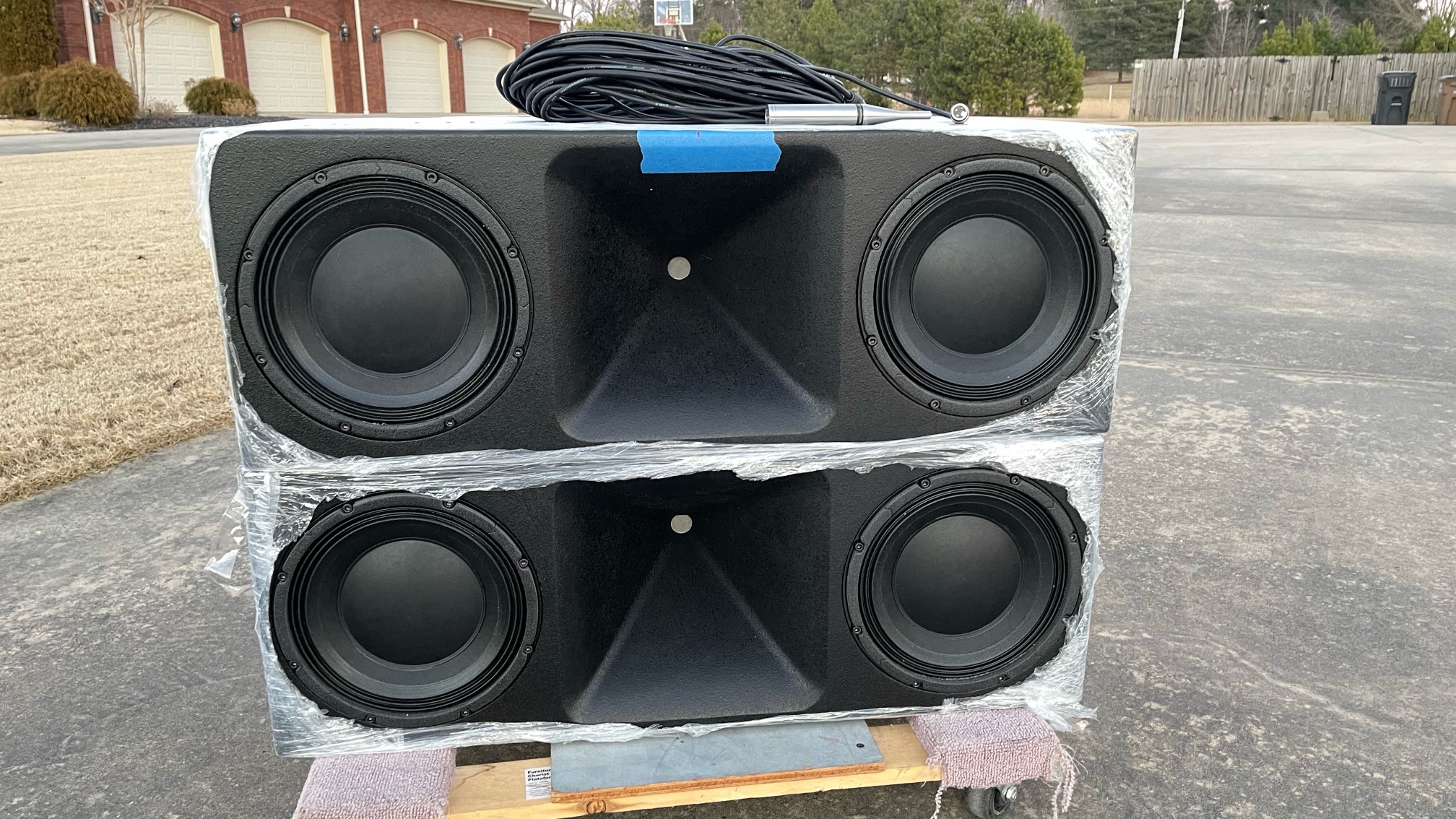
CTA-2034 (SPINORAMA) and Accompanying Data
All data collected using Klippel’s Near-Field Scanner. The Near-Field-Scanner 3D (NFS) offers a fully automated acoustic measurement of direct sound radiated from the source under test. The radiated sound is determined in any desired distance and angle in the 3D space outside the scanning surface. Directivity, sound power, SPL response and many more key figures are obtained for any kind of loudspeaker and audio system in near field applications (e.g. studio monitors, mobile devices) as well as far field applications (e.g. professional audio systems). Utilizing a minimum of measurement points, a comprehensive data set is generated containing the loudspeaker’s high resolution, free field sound radiation in the near and far field. For a detailed explanation of how the NFS works and the science behind it, please watch the below discussion with designer Christian Bellmann:
The reference plane in this test is at tweeter.
Measurements are provided in a format in accordance with the Standard Method of Measurement for In-Home Loudspeakers (ANSI/CTA-2034-A R-2020). For more information, please see this link.
CTA-2034 / SPINORAMA:
The On-axis Frequency Response (0°) is the universal starting point and in many situations it is a fair representation of the first sound to arrive at a listener’s ears.
The Listening Window is a spatial average of the nine amplitude responses in the ±10º vertical and ±30º horizontal angular range. This encompasses those listeners who sit within a typical home theater audience, as well as those who disregard the normal rules when listening alone.
The Early Reflections curve is an estimate of all single-bounce, first-reflections, in a typical listening room.
Sound Power represents all of the sounds arriving at the listening position after any number of reflections from any direction. It is the weighted rms average of all 70 measurements, with individual measurements weighted according to the portion of the spherical surface that they represent.
Sound Power Directivity Index (SPDI): In this standard the SPDI is defined as the difference between the listening window curve and the sound power curve.
Early Reflections Directivity Index (EPDI): is defined as the difference between the listening window curve and the early reflections curve. In small rooms, early reflections figure prominently in what is measured and heard in the room so this curve may provide insights into potential sound quality.

Early Reflections Breakout:
Floor bounce: average of 20º, 30º, 40º down
Ceiling bounce: average of 40º, 50º, 60º up
Front wall bounce: average of 0º, ± 10º, ± 20º, ± 30º horizontal
Side wall bounces: average of ± 40º, ± 50º, ± 60º, ± 70º, ± 80º horizontal
Rear wall bounces: average of 180º, ± 90º horizontal
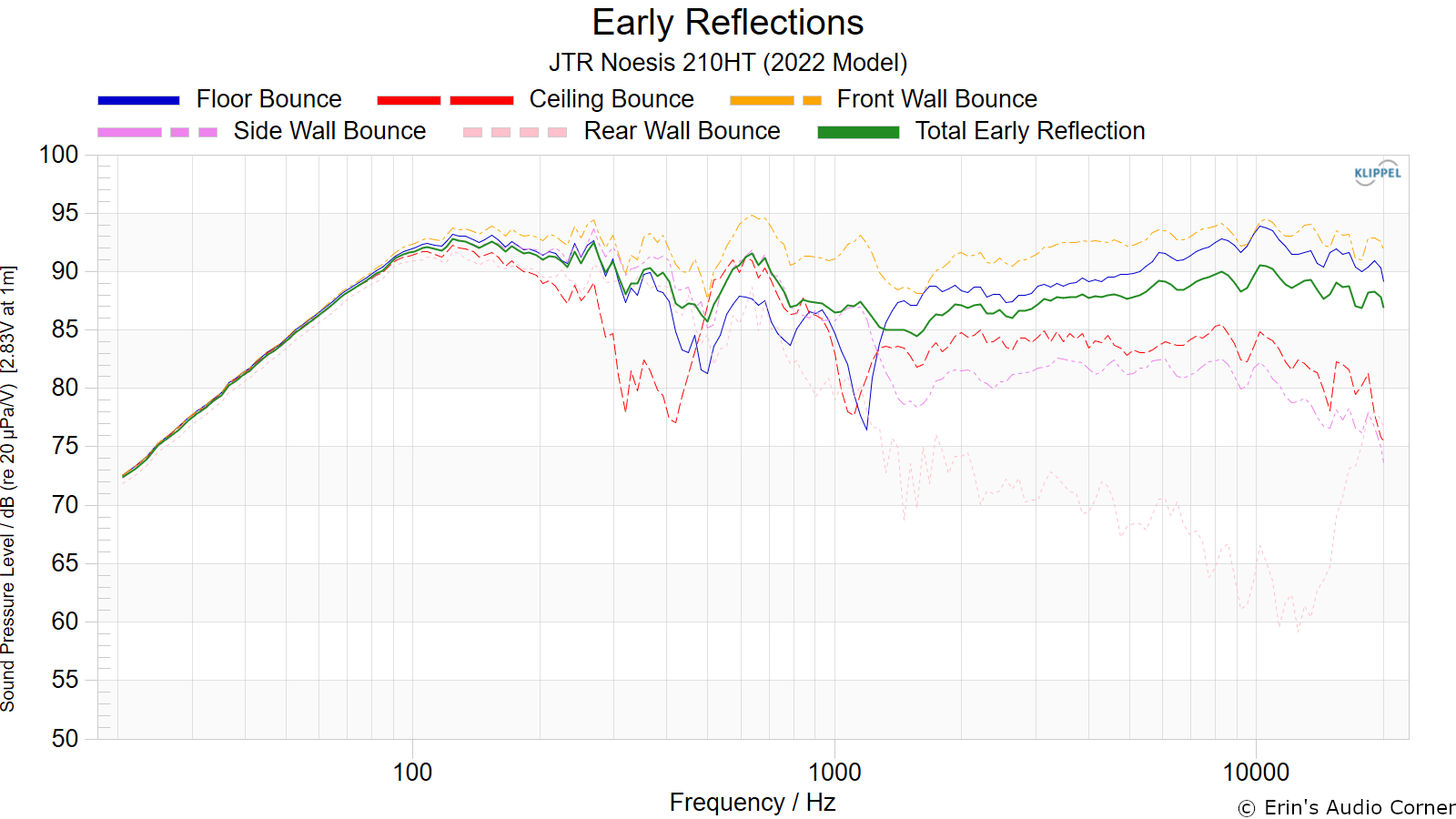
Estimated In-Room Response:
In theory, with complete 360-degree anechoic data on a loudspeaker and sufficient acoustical and geometrical data on the listening room and its layout it would be possible to estimate with good precision what would be measured by an omnidirectional microphone located in the listening area of that room. By making some simplifying assumptions about the listening space, the data set described above permits a usefully accurate preview of how a given loudspeaker might perform in a typical domestic listening room. Obviously, there are no guarantees, because individual rooms can be acoustically aberrant. Sometimes rooms are excessively reflective (“live”) as happens in certain hot, humid climates, with certain styles of interior décor and in under-furnished rooms. Sometimes rooms are excessively “dead” as in other styles of décor and in some custom home theaters where acoustical treatment has been used excessively. This form of post processing is offered only as an estimate of what might happen in a domestic living space with carpet on the floor and a “normal” amount of seating, drapes and cabinetry.
For these limited circumstances it has been found that a usefully accurate Predicted In-Room (PIR) amplitude response, also known as a “room curve” is obtained by a weighted average consisting of 12 % listening window, 44 % early reflections and 44 % sound power. At very high frequencies errors can creep in because of excessive absorption, microphone directivity, and room geometry. These discrepancies are not considered to be of great importance.

Horizontal Frequency Response (0° to ±90°):

Vertical Frequency Response (0° to ±40°):
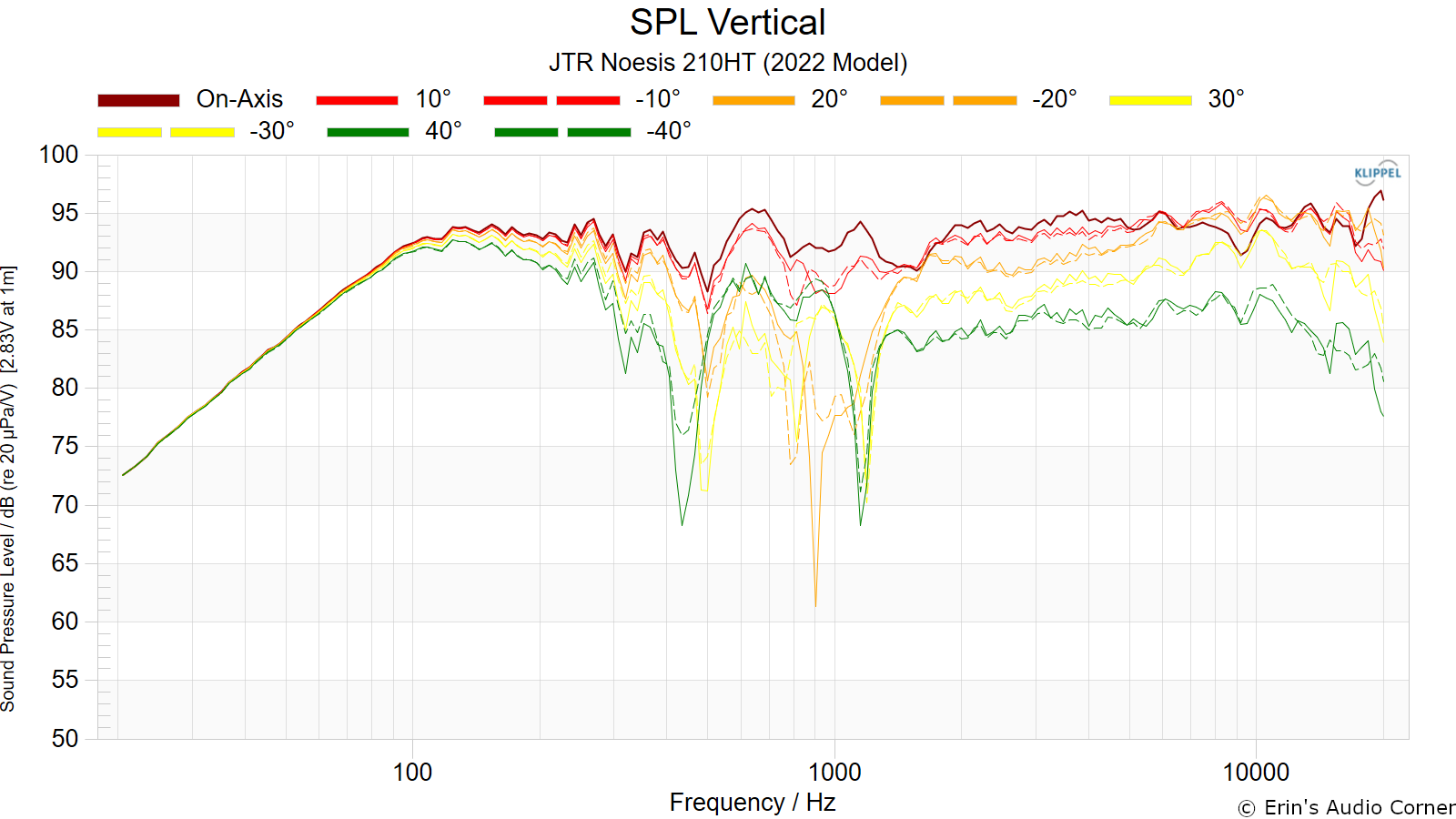
Horizontal Contour Plot (not normalized):
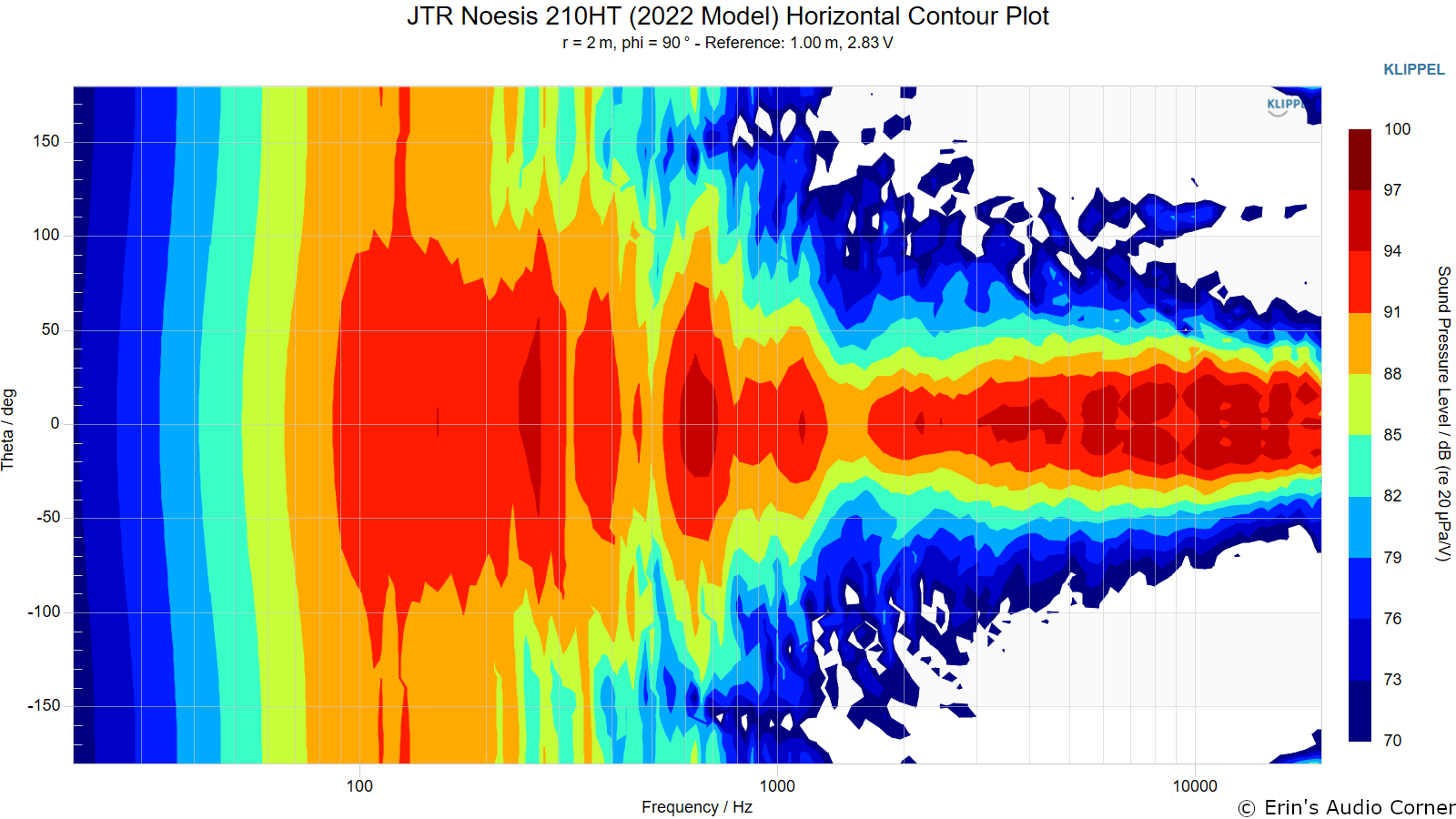
Horizontal Contour Plot (normalized):

Vertical Contour Plot (not normalized):
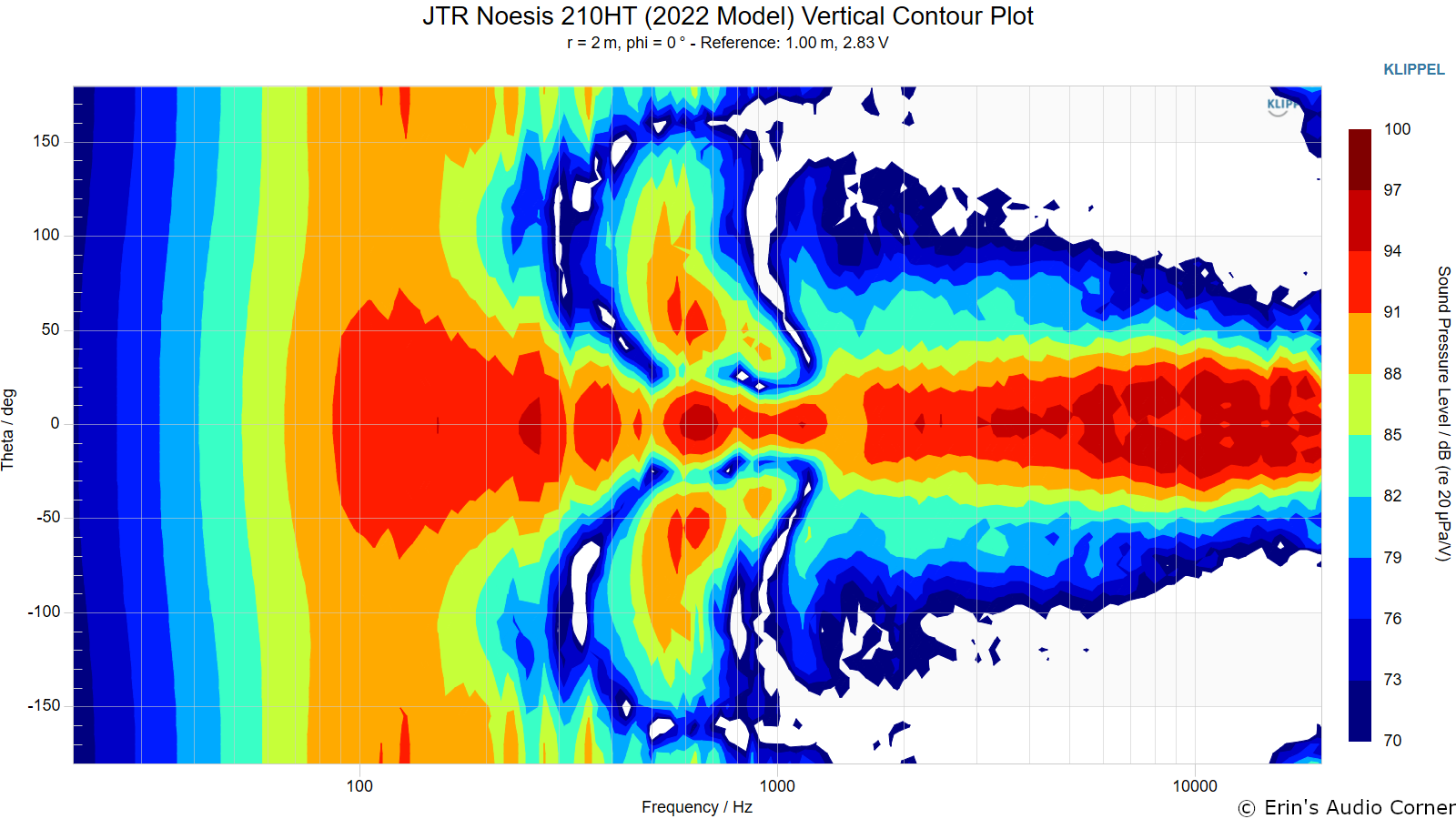
Vertical Contour Plot (normalized):

“Globe” Plots
Horizontal Polar (Globe) Plot:
This represents the sound field at 2 meters - above 200Hz - per the legend in the upper left.
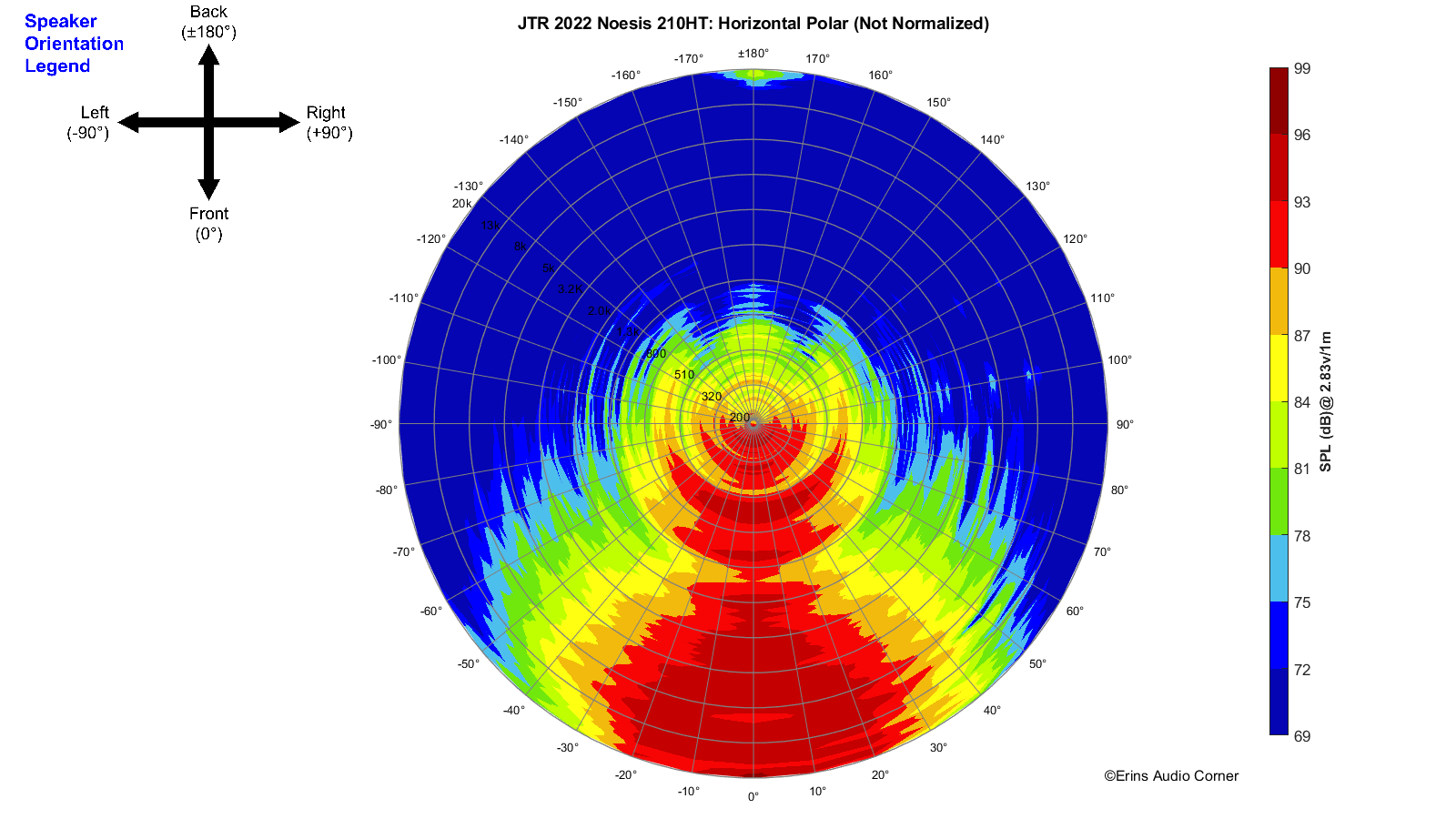
Vertical Polar (Globe) Plot:
This represents the sound field at 2 meters - above 200Hz - per the legend in the upper left.

Additional Measurements
On-Axis Response Linearity
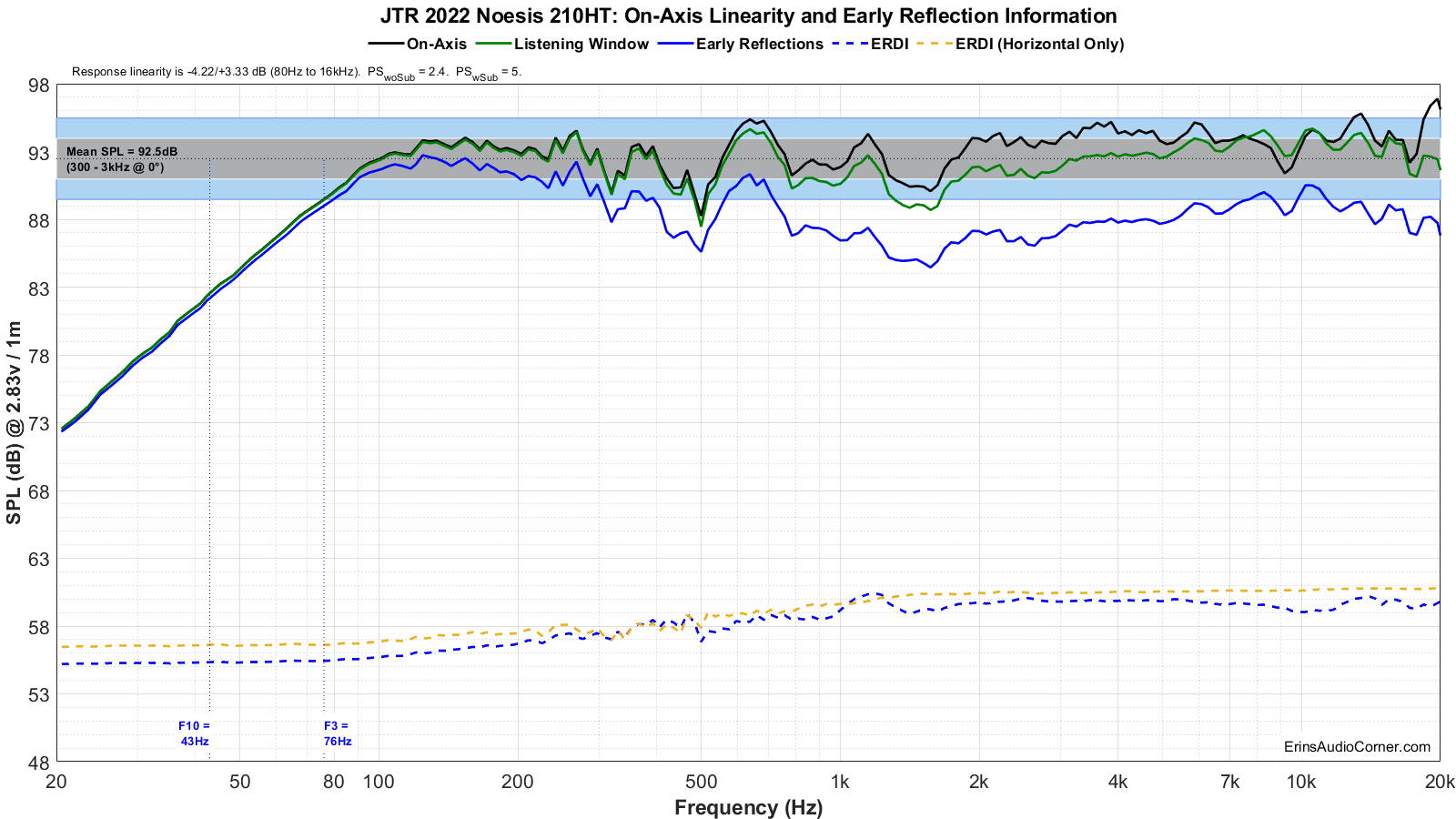
Impedance Magnitude and Phase
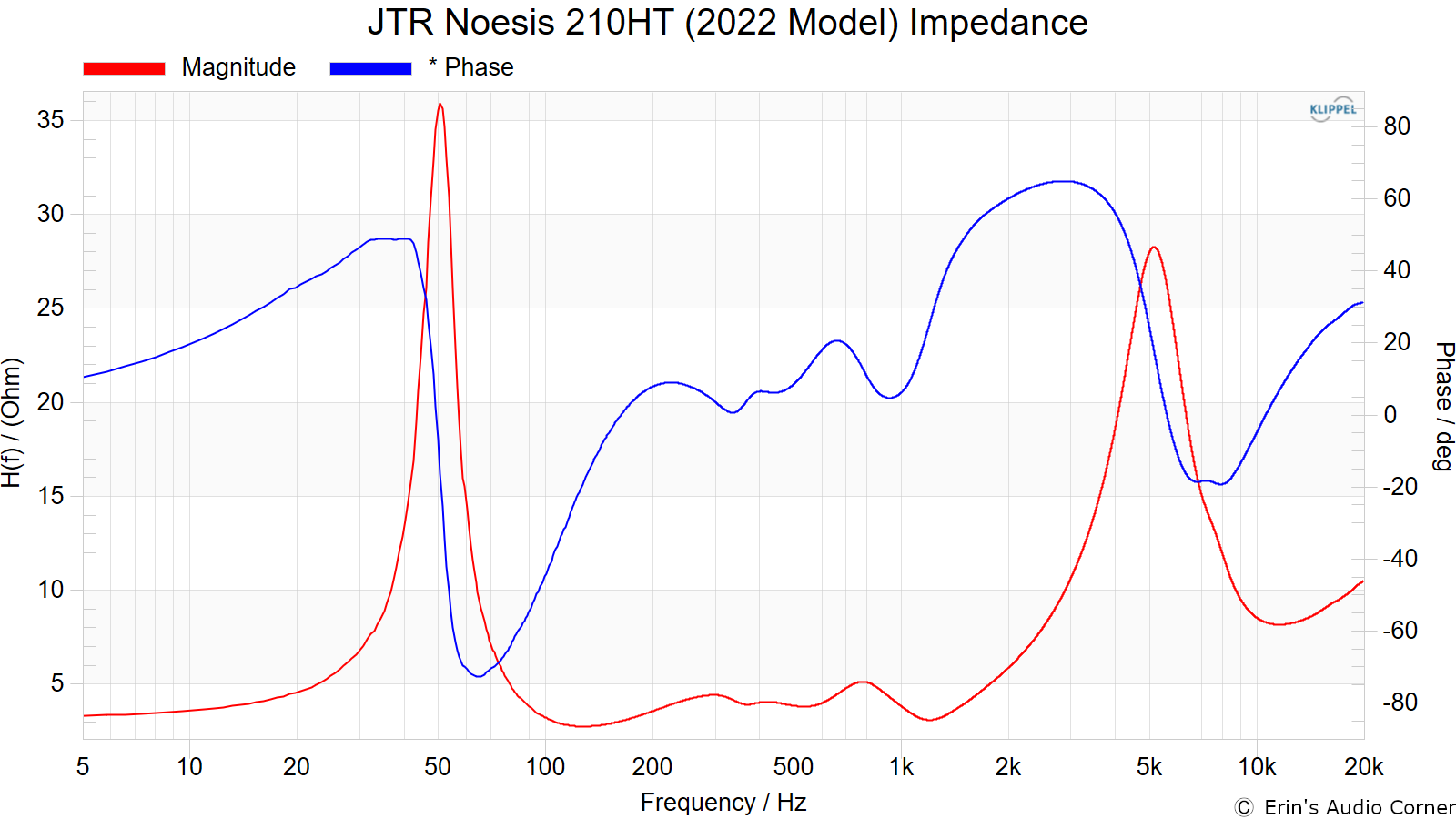
Harmonic Distortion
Harmonic Distortion at 86dB @ 1m:
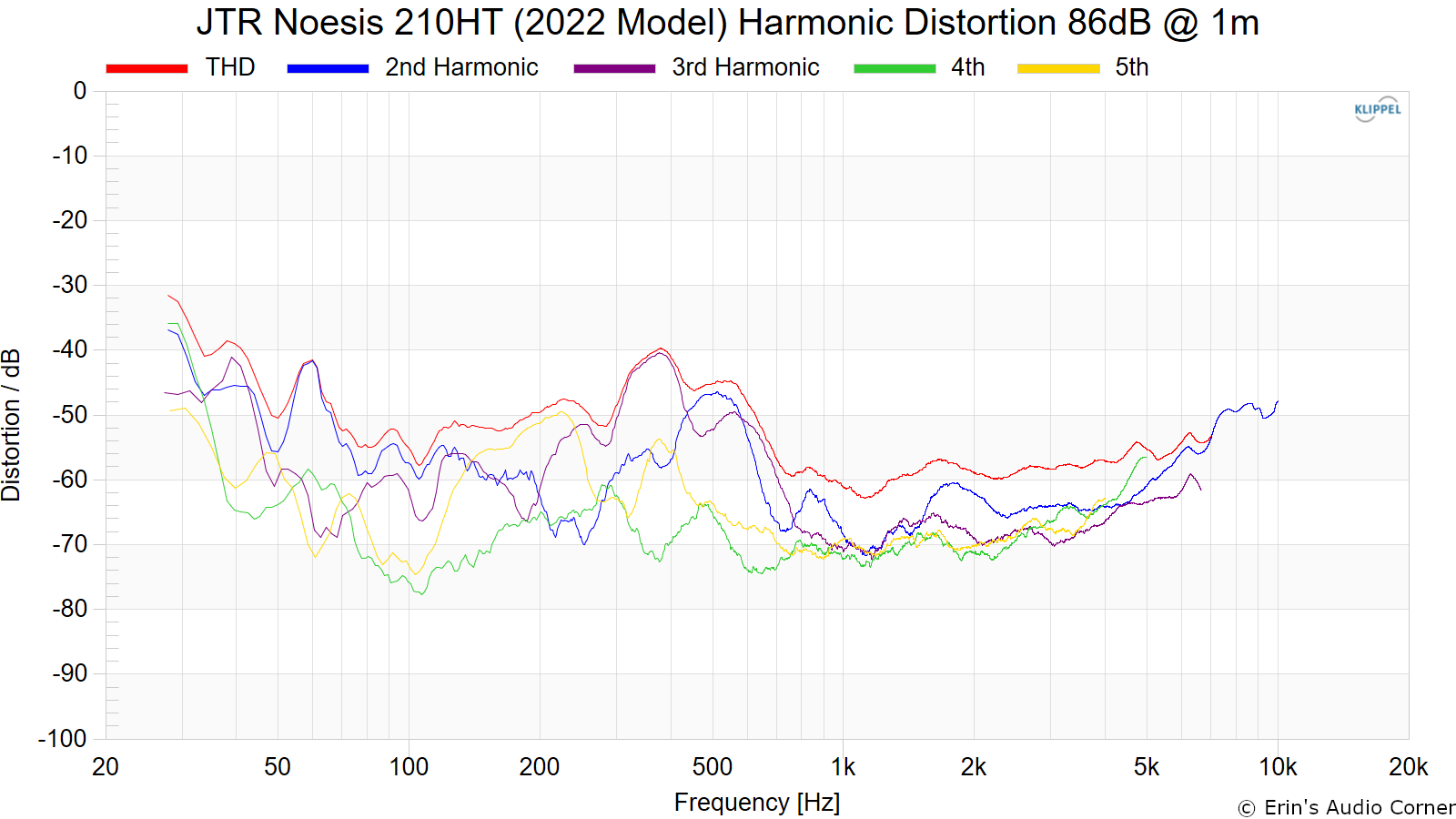
Harmonic Distortion at 96dB @ 1m:

Dynamic Range (Instantaneous Compression Test)
The below graphic indicates just how much SPL is lost (compression) or gained (enhancement; usually due to distortion) when the speaker is played at higher output volumes instantly via a 2.7 second logarithmic sine sweep referenced to 76dB at 1 meter. The signals are played consecutively without any additional stimulus applied. Then normalized against the 76dB result.
The tests are conducted in this fashion:
- 76dB at 1 meter (baseline; black)
- 86dB at 1 meter (red)
- 96dB at 1 meter (blue)
- 102dB at 1 meter (purple)
The purpose of this test is to illustrate how much (if at all) the output changes as a speaker’s components temperature increases (i.e., voice coils, crossover components) instantaneously.
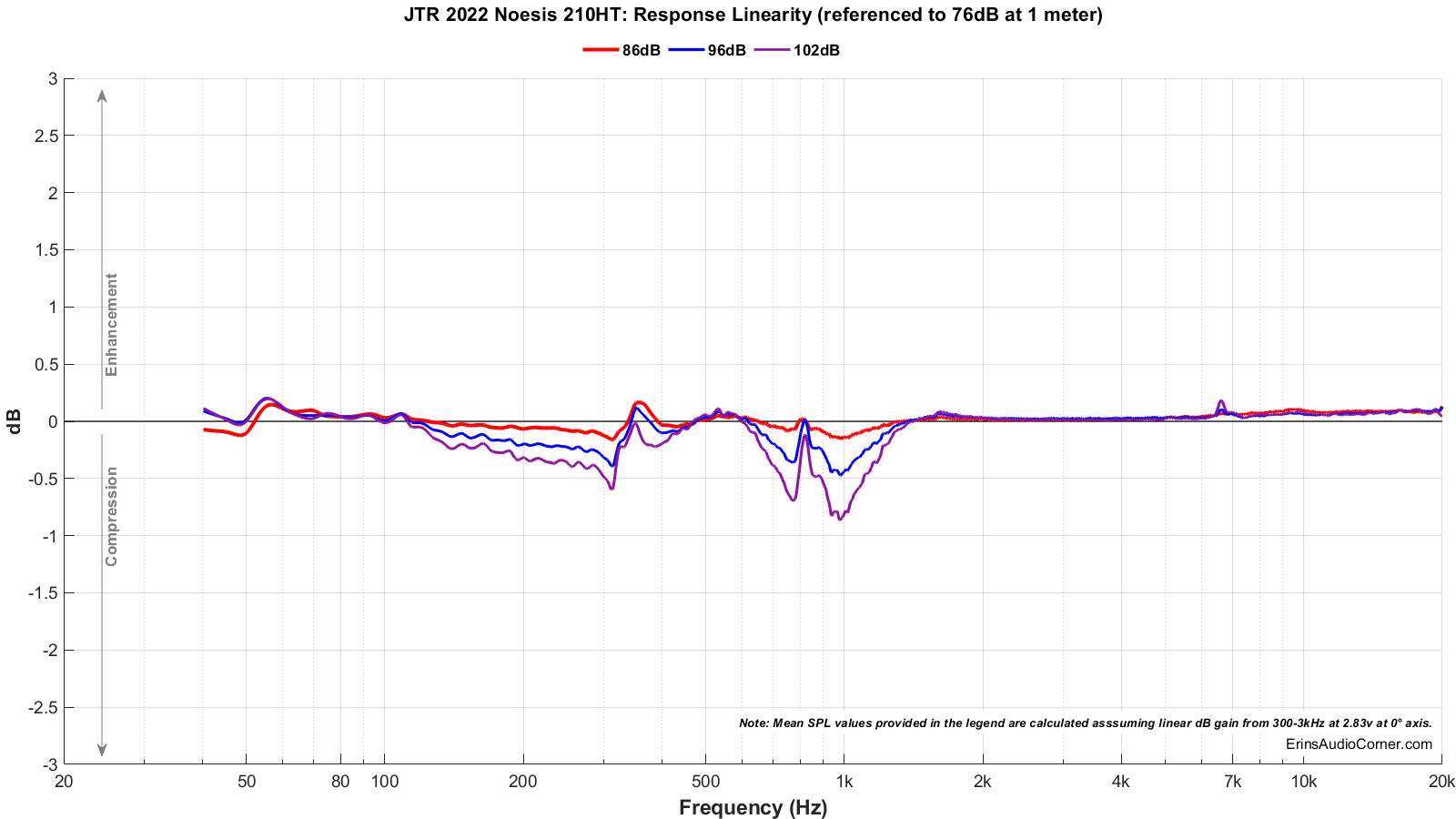
Step Response and Group Delay

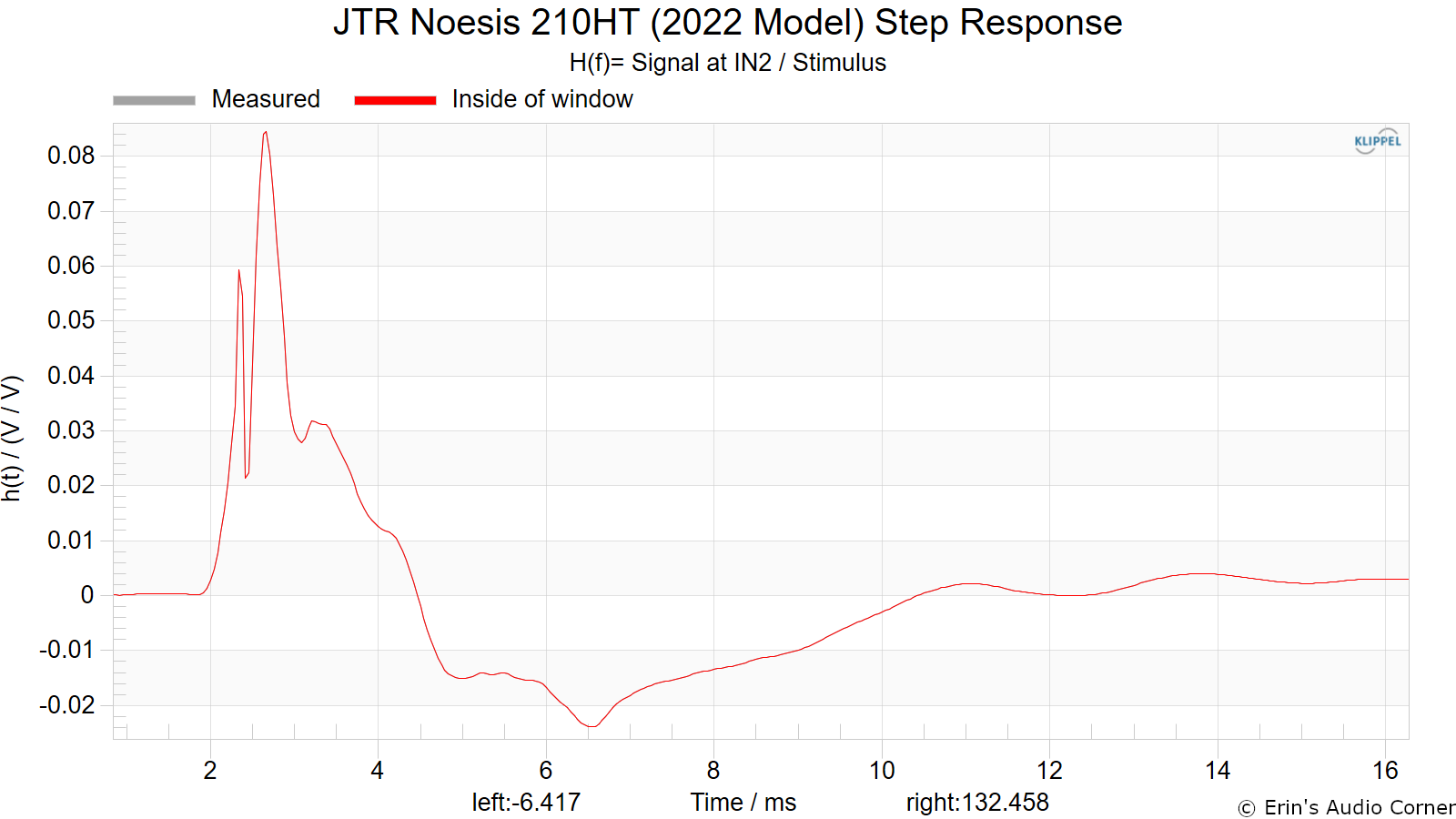
Parting / Random Thoughts
Listening was conducted in my living room at 4m using the Parasound HINT-6 for power. I would have taken them up the stairs into my home theater room but didn’t have anyone around to help me and I didn’t want to bother my wife with that. My living room is a decent size with open floor plan that extends into the hallway, kitchen and dining room.
- Average sensitivity is about 92.5dB @ 2.83v/1m.
- Some pronounced resonances in the midrange were bothersome and the constant directivity of the horn paired with the narrowing directivity of the woofers (or, rather, likely they’re center-to-center spacing) results in a “bright” sounding treble in-room. Looking back at the horizontal SPL and the estimated in-room response, you can see what I mean. The EIR has a downward slope from ~150Hz to 1.5kHz and then shows a slightly rising trend above this frequency up to about 10kHz. This combination lends itself to sound different ways to different people because the frequencies are relative to each other. Personally, I would describe this EIR as “bright”, if I am being succinct in my description. However, with a touch of EQ and a proper HF shelf-filter, this speaker is a beast with tons and tons of output, great detail and excellent imaging.
- Excellent directivity means ability to use EQ at will to shape the sound to your liking.
- Great imaging / focus but not much stage width … or not as much as I like. Toe-out (facing speakers out into listening room) can improve width some with little effect on imaging focus.
- Turning them off-axis also helps remedy the bright sound they had in my room. But this should be played with as different people may prefer a different HF tilt and the trade-off with imaging.
- Crazy loud. Easily fills up my large open-plan living room with sound and no mechanical noise when used with a proper crossover (I landed on 90Hz). I was getting to >110dB at 4m (with hearing protection).
- Heavy.
I’ve had a couple people suggest that the tilted-up HF response could be useful for behind-screen placement. That’s a worthwhile consideration. However, I don’t think the screen would provide enough attenuation. Certainly not for me. I use a DIY screen for my HT and when I tested it some years back, it didn’t result in more than 1-2dB of attenuation, max. I did a quick google search to see what data is available for more popular screens and it looks like that still holds true. Now, a combination of toe-out / in + a screen with enough attenuation might work to provide what is needed but I doubt it would be enough. Especially not 3-5dB of attenuation (a screen with such attenuation would be a terrible design). I wouldn’t rely on the screen to be enough on its own if you wanted to aim the speakers on-axis.
Support the Cause
If you find this review helpful and want to help support the cause there are a few ways you can do so below. Your support helps me pay for new items to test, hardware, miscellaneous items needed for testing and costs of the site’s server space and bandwidth. Any help is very much appreciated.
Or using my generic Amazon affiliate link or Audio Advice link, to purchase items you may need. These links earn me a small commission at no additional cost to you.
You can also join my Facebook and YouTube pages if you’d like to follow along with updates.